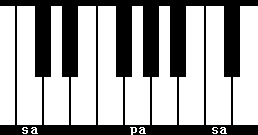

Janya Raagams which are not Bhaashaanga Raagams are known as Upaanga Raagams. A Raagam using all the seven notes of a Melam and is not by definition required to have vakra phrass are also known as Raagaanga raagam and the term Melam or Melakartha is used to refer to the scale or choice of notes rather than the Raagam, which is not a mere combination of notes but has many more attributes.
Though the term Janya means 'born' and Janaka means 'giving birth to', historically the Raagam system existed long before the classification in terms of Melams. Compositions in the 'Janya' Raagam were available before the system of Melams were evolved and Melams were named after Raagams like 'Sriraga' which is today considered as a Janya.
Janya Raagams which omit certain notes may be classified under more than one Melam. For instance Mohanam which omits ma and ni is shown under Melam 65(Kalyani) or Melam 28 (Harikambodhi). See the illustration. The tendency is to put the Janya under a Melam whose Raganga Raagam is closer in bhaavam. However, often Janya Raagams have totally different ways of using the notes and are far removed from the Ragaanga Raagam in bhaavam (ex. Kaanada and Kaapi - Janyas of Kharaharapriya). It will be safer to consider the system as one to find out what notes are used in a Raagam.